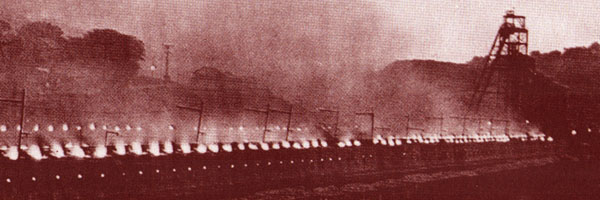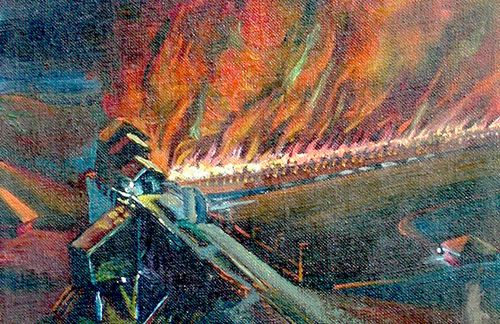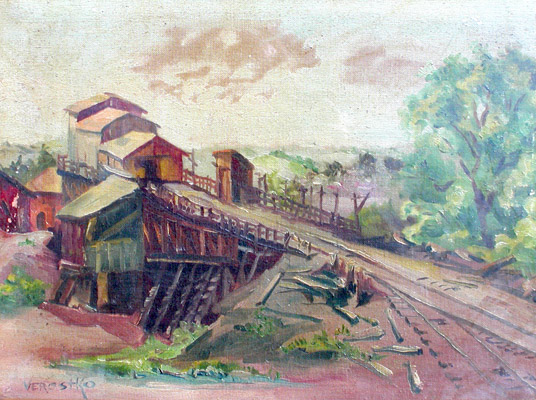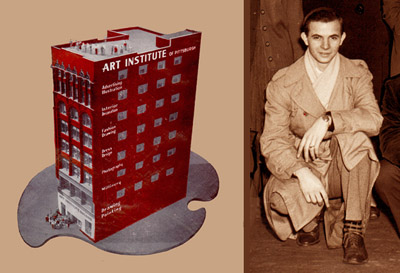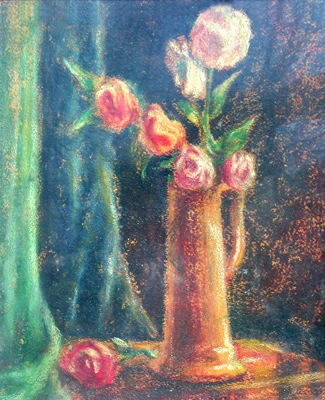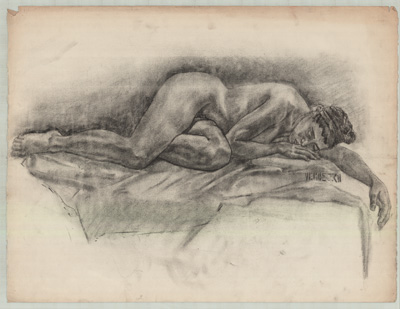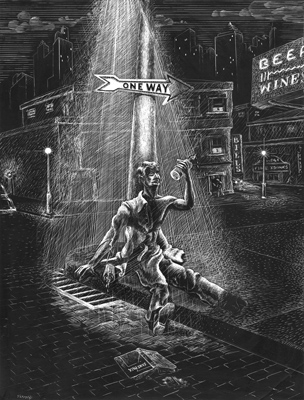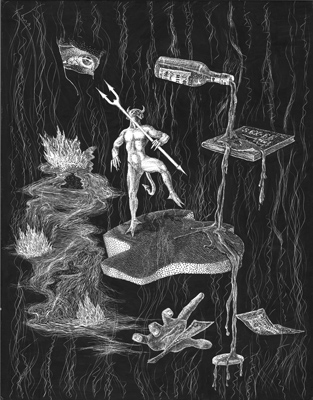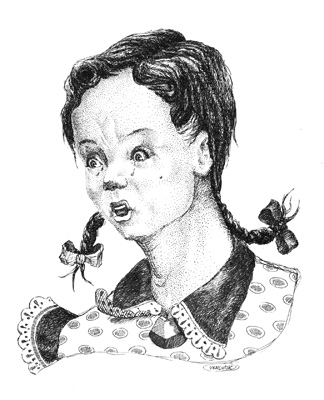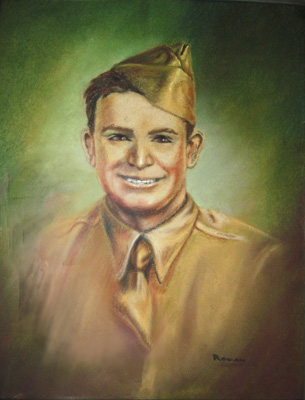< Back to History Menu | Main Menu | Search | Contact
From coal "patch" to the Art Institute of Pittsburgh
Born in 1929, at the beginning of the great depression, my parents named me ''Joseph''. For family and friends, I became known as "Joe" and I assumed the name "Roman" many years later as a monk (note 1) My childhood was colored with the experience of the great depression and the hardships in life for my parents. We grew up in a coal mining town where rows of company houses were clustered in "patches" within walking distance of the mines and the "Company Store". Our ''patch'', called ''Rocktown'' consisted of two rows of houses and a dirt road that led to the Company Store and to the "Central Mine". The mining complex included rows of beehive coke-ovens for converting the coal into coke for the steel mills. The Central ovens were active up to the end of World War II.
Beehive coke ovens at night. Detail from photo by John K. Gates of Uniontown Pennsylvania (c.1930's)At night the beehive coke ovens lit up the sky with a golden glow. One could view beehive ovens burning day and night in almost every coal town along the Blue Ridge. These ovens, carbonizing the coal, belched a thick sooty smoke that literally blackened nearby houses. The ash road near the Company store was nearly always shrouded with a dark cloud and you would see smoke-blackened houses and taste a slimy grit when you walked from our home to the store. My paintings (below) show the beehive ovens and the Central Mine "tipple" before and after they were abandoned following World War II.
Note: The "tipple" is the elevated structure rising from the mine slope from which coal was loaded onto trucks and/or the trolley that fed the coke ovens. The photo above shows an elevated superstructure (far right) for a shaft mine with a vertical access whereas the Central Mine near Tarrs, shown in the paintings below, shows the superstructure for a slope mine with an inclined entrance. In earlier days mules were used to draw loaded mine cars up the slope.
Coke ovens burning at night, oil on canvas board, (detail ) c.16" by 12", ca. 1946-47, Verostko Family (note 2). One of several paintings that included the coal "tipple" of the Bortz coal mine located Southeastward of the 'patch of houses' located at Central, Pennsylvania. This version with ovens burning at night would have been painted from from memory. The coal mine and the ovens were kept very active during World War II. The Central Tipple, oil on canvas board, c.14" by 20" ca. 1949, Verostko Family (note 2). This version of the "tipple" was made several years after the mine had been abandoned. The area where the coke ovens had been located is partially restored.. Several paintings from this period were lost in the 1963 fire at St. Vincent Archabbey. One of my lost treasures was a portrait of my father with the mule he used for hauling coal out of the mine,. The Art Institute of Pittsburgh (AIA)
In 1947, after graduating from the East Huntington Township high school, I moved to Pittsburgh where I found an evening job and attended the Art Institute of Pittsburgh during the day. The Art Institute provided a rich studio program including color, life drawing, portraiture, still life and landscape. The program for illustrators introduced me to the fundamentals of typography, calligraphy, and printing technology. Planning to be both an illustrator and a writer I continued my night job after graduation and worked on my drawing and writing during the day. Within a year my drawing, writing and reading turned to an interest in higher education and a search for greater understanding of my ''Being Here''.
Art Institute of Pittsburgh, 1947-1949. Diploma, 1949. The AIA building and myself at time of graduation. In 1949 the AIA was located on the West side of Smithfield St between 6th and 7th Ave. Image shows a drawing class working in daylight on the roof. The top floor had large studio spaces for life & portrait classes.
Flowers & vase, pastel, 16" by 11.5", ca.1948 , Verostko Family (note 2) . One of a number of still life studies painted during and/or shortly after art school.
Drawing, charcoal, 30 in by 22 in, 1948, artist's collection. Life drawing, both full body and portrait, were important classes for those of us interested in illustration. Vincent Nesbert, who taught me portraiture, may also have been my instructor for this life drawing class. He was known for his murals in the Pittsburgh courthouse and he taught me how to organize my palette colors.
These two moralizing drawings would date from 1949 or early 1950 (artist's collection)
"One Way Street" & "Temptations"
Both are scratchboards, 14" by 16" each.
Technique: Base is white chalk coated with black ink. A sharp tool employed as a pen scratches through the ink to reveal white lines. The process feels like drawing with white lines on a black field.
Pen & ink Drawing, 1949, 12 in by 16 in, artist's collection.
Illustration for a Christmas Story submitted for a
Sunday magazine.George Verostko (1923-1945), pastel, ca. 1949 (Home of Theresa Verostko Lesko). Portrait of my brother, George who was killed in WWII at the age of 22. My mother had no portrait photos of my brother and she requested that I try to achieve a portrait from snapshots and memory. I had seen him for the last time late in August, 1944, before his troop ship sailed for France. Before leaving for Europe he had given me a cap similar to the one in this portrait.
His death, KIA, influenced the course of my life. Click here for my memorial of his life.
Notes:
Note 1. Romanus, my monastic name. It was customary when entering the monastic life to assume a new name symbolizing rebirth wherein one gives up all worldly possessions and associations in pursuit of one's spiritual journey. I chose the name "Romanus" who was, according to the "Dialogues of Gregory", a 6th Century hermit who introduced Benedict to the heremetical life and cared for him for 3 years of isolation in a cave. During this period Benedict underwent spiritual transformation, a prelude to his role as the Abbot of a community of monks at Subiaco. As their spiritual leader Benedict outlined a 72 chapter "Holy Rule" (Sacra Regula), that became the foundation of Benedictine monastic life that spread throughout Europe in the Middle Ages. << back
Note 2 Locations listed as "Verostko Family" refers to the children and or grandchildren of brothers or my sister who saved some works of mine and passed them on to children. Various locations are unknown to me.
DATES. The Coke Ovens Burning at Night, must have been created from memory but I do recall preliminary drawings made at the site for the Central Tipple painting. I also did some landscape painting with an easel out of doors in 1948-49. The coke ovens at night were in full use during WWII as shown in the painting. The company acquired a loud clanking "coke-drawing" machine we could hear day & night during the war. It replaced the coke drawing men who who were drafted for the war. The coke machine was managed by one man who was exempted from military service. Those exempted from service worked up to 16 or 18 hours a day as their contribution to the war effort. .
< Back to History Menu | Main Menu | Search | Contact
Copyright 2001, all rights reserved, Roman Verostko.
